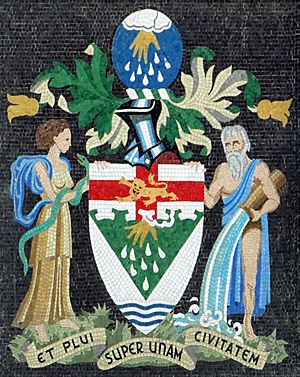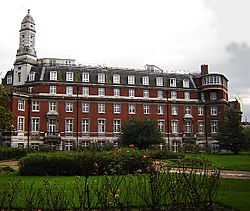Metropolitan Water Board facts for kids

Crest of the Metropolitan Water Board
|
|
| Board overview | |
|---|---|
| Formed | 1903 |
| Dissolved | 1 April 1974 |
| Superseding agency |
|
The Metropolitan Water Board was a special group set up in 1903. Its job was to manage the water supply for London, UK. Members of the board were chosen by local councils in the areas they served.
In 1904, the board took over from eight private companies that used to supply water to Londoners. The Metropolitan Water Board helped greatly expand London's water system. They built many new reservoirs and water treatment plants.
The Metropolitan Water Board stopped operating in 1974. Its control was then given to the Thames Water Authority. This authority later became the private company Thames Water.
Contents
Why London Needed a Water Board
For a long time, London's water supply was managed bit by bit. This was done using special laws and royal permissions starting in 1543.
By 1830, there were ten main companies supplying water to London:
- Six companies supplied water north of the River Thames:
- The New River Company (started 1619)
- The Hampstead Water Company (around 1730)
- The Chelsea Waterworks Company (1723)
- The West Middlesex Waterworks Company (1806)
- The East London Waterworks Company (1807)
- The Grand Junction Waterworks Company (1811)
- Four companies supplied water south of the Thames:
- The Lambeth Waterworks Company (1785)
- The Kent Waterworks Company (1809)
- The Southwark Water Company (around 1760)
- The Vauxhall Water Company (1805)
People started complaining about the water quality. So, in 1827, a special group was formed to investigate. They found the water was often dirty and needed to be much better. Even after this, and several outbreaks of a serious disease called cholera, not much changed.
In 1852, a new law, the Metropolis Water Act 1852, set rules for water companies. It was the first time there were minimum standards for water quality. Later, in 1869, another group suggested that water supply should be managed by the public, not private companies.
Many attempts were made to create a public water supply for London. However, local councils outside London did not want the London County Council to control their water. Because of this, a completely new group was needed to manage water for the greater London area. This new group became the Metropolitan Water Board.
How the Board Was Formed
The Metropolitan Water Board was created by a law called the Metropolis Water Act 1902. The board first met on April 2, 1903. It had 67 members. Most of these members (65) were chosen by local councils. The board also had a paid chairman and vice-chairman.
The local councils that chose members included:
- The London County Council
- The City of London and its boroughs
- County councils from Essex, Kent, Middlesex, Surrey, and Hertfordshire
- Groups managing the River Thames and River Lea
The first board members served until June 1, 1907. After that, new board members were chosen every three years. As local government changed over time, the groups that nominated members also changed.
Companies Taken Over
The Metropolitan Water Board officially took over from the private water companies on June 24, 1904. This happened after special meetings decided how much money would be paid to the companies. The board bought out eight major London water companies:
- The New River Company
- The East London Waterworks Company
- The Southwark and Vauxhall Waterworks Company
- The West Middlesex Waterworks Company
- The Lambeth Waterworks Company
- The Chelsea Waterworks Company
- The Grand Junction Waterworks Company
- The Kent Waterworks Company
The board also took over the water services of Tottenham and Enfield councils. They also acquired the Staines Reservoirs Joint Committee. The total amount paid to the companies was about £47 million. This money was given as "water stock," which paid a small yearly income for 80 years.
Area the Board Served
The area the Metropolitan Water Board supplied was much larger than just the main part of London. It covered about 559 square miles (1,448 square kilometers). This included all of the County of London and a large part of Middlesex. Its outer edges reached places like Cheshunt in Hertfordshire and Dartford in Kent.
In 1911, the Encyclopædia Britannica described "Water London" as a spread-out area. It went from Ware in Hertfordshire all the way to Sevenoaks in Kent. It also stretched west to Ealing and Sunbury.
Where the Water Came From
The Metropolitan Water Board got its water from several places. These included:
- The River Thames
- The River Lea
- Springs and wells in the Lea valley, Kent, and the southern district
- The Hanworth gravel beds
- Hampstead and Highgate ponds
The board also supplied water to some other local water companies and councils outside its main area.
The Board's Last Years
In 1965, local government in Greater London was changed. Because of this, the way the board was set up also changed. From November 1, 1965, until it closed on April 1, 1974, the board had 39 members. These members were chosen by various councils, including:
- The Greater London Council
- The City of London
- Many of the London borough councils
- The county councils of Essex, Kent, Surrey, and Hertfordshire
- The groups managing the River Thames and River Lea
Members of the board served for three years. The chairman and vice-chairman were chosen by the board each year.
End of the Board
In 1973, a new law called the Water Act 1973 changed how water was managed across England and Wales. Ten large water authorities were created. These new authorities were based on river systems.
So, in 1974, the Metropolitan Water Board's responsibilities were passed to the Thames Water Authority. This new authority had a 60-person board. It covered a very large area, from where the Thames starts in Wiltshire all the way to the Thames Estuary.
See also
- London water supply infrastructure
- National Union of Water Works Employees


